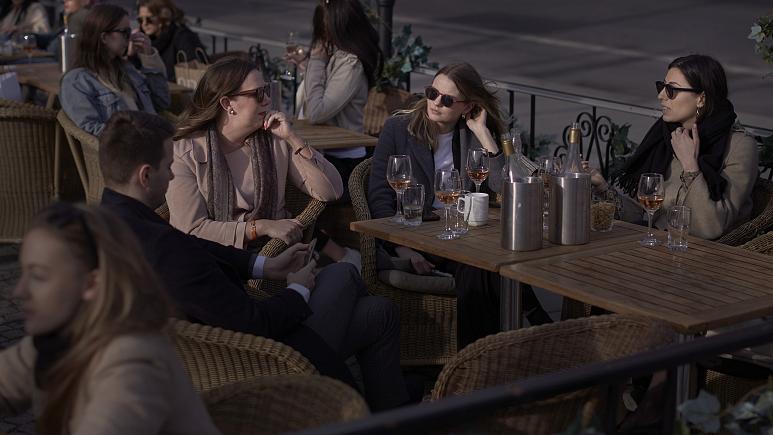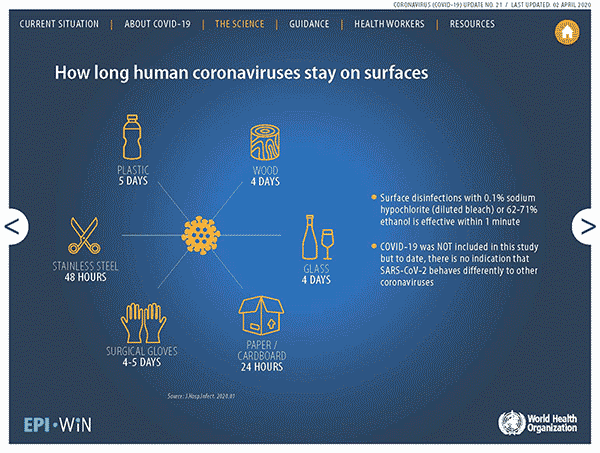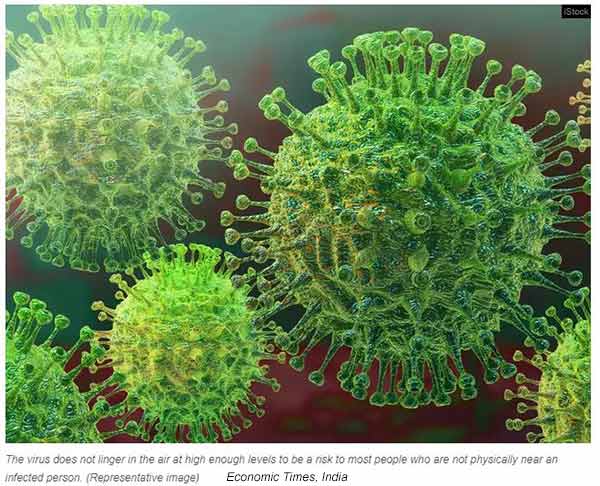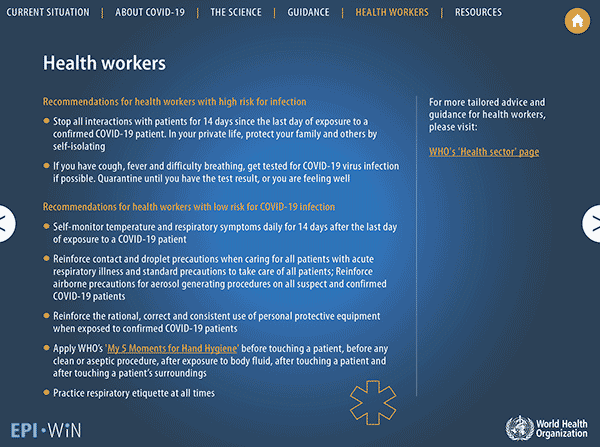How to Prevent Infection through Keeping COVID-19 from your Face
Your face is the gateway to the Coronavirus infection.
Don't let your hands open the gate!!
You touch your face 16 times an hour.
Note how many are touching their faces! Stop the face touching, stop the virus.

How to stop touching your face. https://www.healthline.com/health-news/how-to-not-touch-your-face
For discussion on LOCKDOWN options and government responses see
https://covid-19-plan-b.com/index.htm
The COVID-19 virus has a relatively long life on surfaces, so you cannot be sure that anything you touch outside your home is not infected!

It cannot be emphasised enough that TOUCHING near your mouth, eyes or nose with possibly virus contaminated hands is the most likely cause of infection.
Why?
Unless you can be certain that your hands will not touch your face, consciously or unconsciously, a shield or similar barrier is needed.
The best solution would appear to be a full face shield that has side pieces that prevent your hands also touching your hair and head when removing the shield.
A veil or similar covering over the whole face will help, but wash your hands before removing, and don't touch your face with possibly contaminated hands when removing.
A surgical mask will prevent you from touching your mouth and nose, but not your eyes, and needs to be removed without contaminating your face.
To stop spreading the virus to others, wear a cloth mask.
Wear a full face shield to stop getting the virus.
Cloth masks may become compulsory in SA post-lockdown
23 April 2020
According to Business Insider SA, South Africans may be compelled to use cloth masks when using any form of transport when the national lockdown is set to lift at the end of April, according to a draft document by the presidency.
Hand sanitisers must also be made available, and all passengers will be required to sanitise their hands before using any form of transport.
An excellent suggestion and one for which President Cyril Ramaphosa should be commended.
It means that when travelling your hands are less likely to come in contact with the virus, and your fellow passengers are less likely to spread germs. Source https://www.businessinsider.co.za/cloth-masks-may-become-compulsory-in-sa-post-lockdown-2020-4.
A shield will give more certain protection especially against face touching when surrounding surfaces may not be virus-free, such as when in public or the workplace amongst others.

These are three of the exact instructions given by the WHO and echoed by every health organisation but in the wrong order!
Source: https://www.who.int/emergencies/diseases/novel-coronavirus-2019/advice-for-public
1. Wash your hands frequently
Why? Washing your hands with soap and water or using alcohol-based hand rub kills viruses that may be on your hands.
2. Maintain social distancing
Why? When someone coughs or sneezes they spray small liquid droplets from their nose or mouth which may contain the virus. If you are too close, you can breathe in the droplets, including the COVID-19 virus if the person coughing has the disease. If you are social distancing infection this way is unlikely.
3. Avoid touching eyes, nose and mouth.
Why? Hands touch many surfaces and can pick up viruses. Once contaminated, hands can transfer the virus to your eyes, nose or mouth. From there, the virus can enter your body and can make you sick.
Why the wrong order? Because the highest and for most the only risk of a non-medical person getting infected is unknowingly and repetitively touching their face after their hands have inadvertently come in contact with a contaminated surface.
The WHO instructions should make it clear that every time you touch a possibly contaminated item or surface, you need to wash your hands before touching your face, and if you cannot control your hands they require a barrier between their hands and their face like a face shield.
The WHO should also clarify the meaning of the new phrase "social distancing", explaining it rather in the more familiar terms of "personal space", "elbow room" or "breathing space".
The so-called super-spreaders maybe those infected who spit a lot when talking.
Who, when, and why wear a Mask or Shield?
"In an analysis of 75,465 COVID-19 cases in China, there was no airborne transmission reported."
The WHO says without evidence of airborne transmission, and it does not recommend the public wear masks to prevent catching COVID-19, which means that the WHO and most research says that you cannot normally catch the virus floating around in the air around you.
Medical workers who may be in very close contact with patients need masks, preferably the N95; also shields since their risk of having a patient spray into their face is high.
To protect others and if there is any chance you have contracted COVID-19, wear a type of cloth mask to prevent contamination escaping, which may be compulsory in some countries. It will impede you catching the virus through your mouth and nose, but offers no protection should you rub your eyes with contaminated hands. If you adjust or touch the mask and your face with contaminated hands, that could transfer the infection to your face.
For protection against catching the virus, wear a shield that covers your face and prevents the touching of your face.
Logical Conclusion
The only way the virus can enter your body is through your eyes, nose and mouth, (except through an open cut) and there are only three ways the infection can get to your eyes, nose mouth.
One is being too close to an infected person who coughs, sneezes or spits close enough to land on your face.
Two is touching something that an infected person has touched, coughed, sneezed or spat on, or something that has been touched by someone who has touched something an infected person has touched, coughed, sneezed or spat on and so on, and then touching your face with hands that carry infection.
Three is your face touching something that has the virus.
The unarguable conclusion must be if you wear a mask or shield that protects you from human spray and allows nothing contaminated to touch your face, the virus cannot enter the body, i.e. you are protected.
Abundance of caution procedures
"So far, evidence suggests that it's harder to catch the virus from a soft surface (such as fabric) than it is from frequently touched hard surfaces like elevator buttons or door handles," wrote Lisa Maragakis, MD, senior director of infection prevention at the Johns Hopkins Health System. Source https://www.webmd.com/lung/news/20200401/coronavirus-on-fabric-what-you-should-know
Although some emergency workers throw everything, they were wearing into the wash as they get home, and if the soap doesn't get the virus, the hot water above 133F or 56C will.Don't forget that buttons are hard surfaces.Your shoes can pick up the virus, so either leave them outside or wipe them with sanitiser
Source https://medical.mit.edu/three-ways-to-protect
There are several other Prevention measures

Common sense would suggest that you keep at least 2 meters from anyone coughing or sneezing, and try a keep at least one meter away from everyone except members of your household.
23 April 2020. It appears that the virus survives for ¼ as long on cardboard, but since cloth has a similar texture to cardboard, can we assume that covering hard surfaces with material or paper shortens the life of the virus lying on those surfaces?
Sunlight and Virus
There have been assertions and denials that sunlight kills the COVID-19 virus.
A new report, not yet peer reviewed says "Sunlight kills coronavirus very quickly" but most experts are cautious.
Link here https://www.yahoo.com/news/sunlight-destroys-coronavirus-very-quickly-new-government-tests-find-but-experts-say-pandemic-could-still-last-through-summer-200745675.html.
Vitamin D and Zinc
There is growing non scientific literature that Vitamin D and Zinc inhibit the COVID-19 virus. Taking them should do no harm except to your pocket, and in a sea of bewilderment they could be effective.
Source
https://chrismasterjohnphd.com/covid-19/what-is-the-best-dose-of-zinc-for-covid-19-prevention and
https://childrenshealthdefense.org/news/covid-19-and-vitamin-d-could-we-be-missing-something-simple/?utm_source=salsa&eType=EmailBlastContent&eId=2fd38bdc-a9a8-4267-a4c9-78fb17599e7c.
Nursing homes and the aged
For the elderly who may not be able to control their hands, it may be advisable to cover their face with a full face shield, a veil or something similar.
Since the virus is hazardous to the infirm and elderly, they must be particularly protected from face contact, particularly since many of their carers will be exposed when travelling to work or even at work.
A veil or similar covering over the whole face will help, but not if you touch the face with possibly contaminated hands when fitting it or removing it.
A less intrusive option to stop the elderly touching their face, particularly the eyes may be to wear glasses or workman's protective goggles.
Carers should follow hospital sanitary rules, wash or sterilise their hands between each person.
There are special prevention measures for Health Workers

About breathing the same air as a COVID-19 patient
This new document from the WHO discusses the various forms of infection transmission and concludes that there is unlikely to be a COVID-19 airborne transmission, but droplet transmission is common.

Some scientists consider that it is possible that COVID-19 patient breathing except under specific medical procedures may spread the virus, although the WHO questions this.
WHO says "in an analysis of 75,465 COVID-19 cases in China, airborne transmission was not reported".
This is taken directly from a WHO report
https://www.who.int/docs/default-source/coronaviruse/risk-comms-updates/update-21-epi-win-covid-19-transmission-q-a.pdf?sfvrsn=796a4b2b_2
COVID-19 spreads through droplet transmission - respiratory droplets that are relatively heavy, do not travel far and fall quickly to the ground and other surfaces. Extensive contamination of the environment can occur. Although airborne spread seems to be unlikely in normal circumstances, further evidence is needed before it is considered an insignificant mode of transmission.

The U.S. Centers for Disease Control and Prevention (CDC) also recommends wearing face masks in public settings to prevent catching or spreading the disease, even though coronavirus airborne transmission is “unlikely.”
A CDC report that virus droplet nuclei aerosols can stay suspended in the air is probably the basis for discussion on airborne transmission as against droplet transmission.
T
However the WHO criticised this report since the droplets were detected near where medical procedures had taken place or where droplets were generated by a nebuliser which does not reflect normal human cough conditions. The "WHO continues to recommend droplet and contact precautions", (but not nuclei aerosol precautions.)
It is amazing that in 2020 such a basic medical question has no definite answer.
If tiny drops generated from breathing and probably coughing containing coronavirus remain suspended for some time, then a face mask is both of use as protection against inhaling the virus and preventing spreading.
If the drops do not remain suspended for much time, a mask will help stop the normal wearer from spreading, but only a shield stops the wearer touching contaminated surfaces and then touching their face.Medical personal in close contact with COVID-19 patients must wear at least the N95 mask, plus a medically approved face shield.
CDC report here
https://www.cdc.gov/niosh/topics/aerosols/pdfs/Aerosol_101.pdf and
https://www.ncbi.nlm.nih.gov/books/NBK143281/.
https://economictimes.indiatimes.com/magazines/panache/how-long-can-coronavirus-live-on-surfaces-or-in-the-air/articleshow/74690737.cms?from=mdr
Click her for WHO report.
Click here for discussion on aerosols.
Link to research on droplet sizes and gravity rates.
 Routes of transmission
Routes of transmission
COVID-19 is transmitted via droplets and fomites during close unprotected contact between an infector and infectee.
Airborne spread has not been reported for COVID-19 and it is not believed to be a major driver of transmission based on available evidence; however, it can be envisaged if certain aerosol-generating procedures are conducted in health care facilities>
The World Health Organisation (WHO) has also released guidelines on this, saying that airborne bioaerosol transmission of COVID-19 has not been reported, except in very specific circumstances like removing a patient from a ventilator or manual ventilation.
Source https://www.sciencealert.com/is-coronavirus-spread-by-talking-and-breathing.
Surgical masks are particularly useful if worn by sick individuals. This intervention will help keep an infected person from spreading viruses around, as they come out even when you’re just exhaling. If you’re not sick but are around people who have the flu, wearing a surgical mask can help protect you from getting infected as long as it’s tight-fitting. If there are gaps around the sides, then it’s not helping much.
The sun, fresh air virus in 1920
In 1918 putting infected patients out in the sun may have helped because it inactivates the influenza virus. It also kills bacteria that cause lung and other infections in hospitals. During the First World War, military surgeons routinely used sunlight to heal infected wounds. They knew it was a disinfectant. What they didn’t know is that one advantage of placing patients outside in the sun is they can synthesise vitamin D in their skin if sunlight is strong enough. A fascinating article that showed how simple changes to treatment could reduce the death rate from 40% to 13%.
https://medium.com/@ra.hobday/coronavirus-and-the-sun-a-lesson-from-the-1918-influenza-pandemic-509151dc8065
R0, the Metric That May Soon Shape Our Lives
‘R-naught’ represents the number of new infections estimated to stem from a single case. If on average, each patient infects two others, then the rate of infection is doubling, and that is bad news. If only half the patients infect another person, that means that the infections are reducing. If the R0 is zero, then we have the virus beat.
It appears that COVID-19 transmits easier than SARS, so most of our efforts should be dedicated to stopping transmission!






 Some scientists consider that it is possible that COVID-19 patient breathing except under specific medical procedures may spread the virus, although the WHO questions this.
Some scientists consider that it is possible that COVID-19 patient breathing except under specific medical procedures may spread the virus, although the WHO questions this. Routes of transmission
COVID-19 is transmitted via droplets and fomites during close unprotected contact between an infector and infectee. Airborne spread has not been reported for COVID-19 and it is not believed to be a major driver of transmission based on available evidence; however, it can be envisaged if certain aerosol-generating procedures are conducted in health care facilities>
Routes of transmission
COVID-19 is transmitted via droplets and fomites during close unprotected contact between an infector and infectee. Airborne spread has not been reported for COVID-19 and it is not believed to be a major driver of transmission based on available evidence; however, it can be envisaged if certain aerosol-generating procedures are conducted in health care facilities>